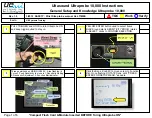
MFJ-259B Instruction Manual
HF/VHF SWR Analyzer
20
tuned according to the manufacturer’s instructions while tested with the MFJ-259B, until the
desired SWR is obtained.
7.0 TESTING AND TUNING STUBS AND TRANSMISSION LINES
7.1 Testing
Stubs
Resonant frequency of any impedance stub or transmission line can be measured. Select the first (or opening)
measurement mode in the MAIN menu.
Connect the stub under test to the "ANTENNA" connector of the MFJ-259B.
Note:
The line must be
open circuited
at the far end
for odd multiples
of 1/4 wave stubs (i.e. 1/4, 3/4,
1-1/4, etc.) and
short circuited
for all half-wave stub
multiples
(like 1/2, 1, 1-1/2, etc.).:
If a
balanced line
is used, operate the MFJ-259B
only
from internal batteries. Keep the MFJ-259B a few feet
away from other conductors or earth, and do not attach any wires (other than the feedline) to the unit. Use the
ANTENNA connector’s shield for one lead and its center pin for the other. Two wire balanced lines
must
be
suspended in a fairly straight line a few feet away from metallic objects or ground.
Coaxial lines
can lay in a pile or coil on the floor. Internal or external power can be used, and the MFJ-259B can
be placed on or near large metallic objects with no ill effects. Coaxial lines connect normally, with the shield
grounded.
When tuning critical stubs,
gradually
trim the stub to frequency. Adjust the feedline or stub using the following
method:.
1.) Determine the desired frequency and theoretical length of the feedline or stub.
2.) Cut the stub 20 percent longer than calculated, and short the far end of a half-wave (or multiple of a half-
wave) stub or feedline. Leave the far end open for feedlines or stubs that are 1/4 wavelength or odd multiples
of 1/4 wl long.
3.) Measure frequency of lowest resistance and reactance, or lowest impedance. For fine tuning look only at the
“X=?” display. Adjust for X=0, or as close as X=0 as possible. The frequency should be about 20% below
the desired frequency if everything worked as planned during the length calculation.
4.) Divide the measured lowest “X” frequency by the desired frequency.
5.) Multiply the result by the length of the feedline or stub to find the required length.
6.) Cut the stub to the length calculated in step 5, and confirm lowest “X” is on he desired frequency.
7.2
Velocity Factor of Transmission Lines






































